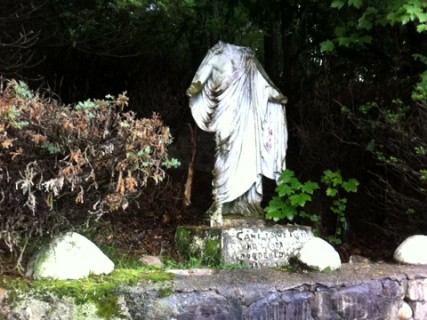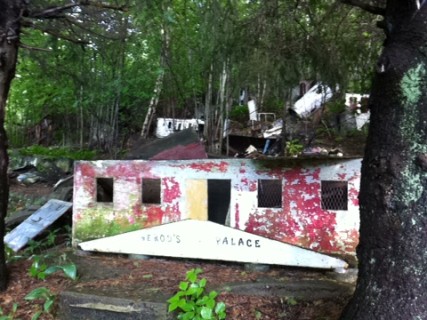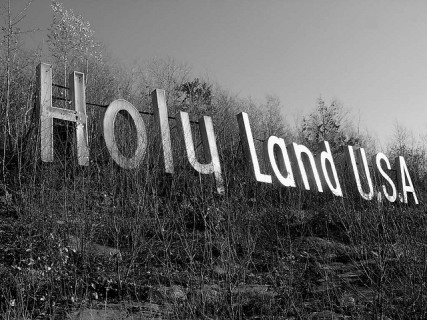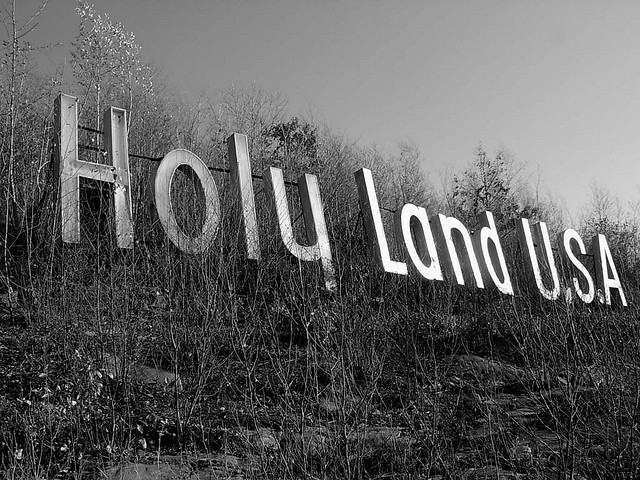WATERBURY, Conn. (RNS) The Garden of Gethsemane is gone. The Via Dolorosa, now overgrown with brush, is impassable. A statue of Christ with outstretched arms at the park’s entrance is missing a head. The roof on Herod’s Temple has collapsed.

Abandoned Holy Land USA, a Catholic shrine in Waterbury, Conn. built by John Baptist Greco in 1950s, has found a buyer. RNS photo by Ann Marie Somma/Hartford FAVS
Holy Land USA once awed the curious and the faithful. Lately it endured vandalism, wrestled (and lost) a battle with nature and faded from memory.
Now the abandoned Bible-themed shrine from the 1950s may find new life.
Waterbury Mayor Neil O’Leary and local car dealer Fritz Blasius bought the 17-acre ruin from the Morristown, N.J-based Pontifical Institute for the Religious Teachers Fillippini.
The park closed in 1984, two years before the death of its founder, John Baptist Greco, a devout Roman Catholic. He left the property to the order of nuns who watched it crumble from their convent window on the site, eschewing several attempts to restore the park.
O’Leary told The Waterbury Observer that he and Blasius will form a nonprofit to raise the $350,000 to turn the property into a Christian shrine where the city’s ethnic groups can display their faith.
A Yale University graduate and seminary school dropout, Greco built the once-vibrant miniature replica of Bethlehem and Jerusalem out of plywood, scrap metal and discarded objects. His years of toil turned a craggy mountaintop into an attraction that drew thousands of Christian pilgrims in the 1950s, ‘60s and ‘70s.
“Holy Land was his prayer, his expression of the Catholic faith,” said the Rev. Frank Papa, who lived with Greco at Holy Land during the late 1970s and early 1980s.

Abandoned Holy Land USA, a Catholic shrine in Waterbury, Conn. built by John Baptist Greco in 1950s, has found a buyer. RNS photo by Ann Marie Somma/Hartford FAVS
Papa recalled how Greco practiced law during the day and chiseled biblical passages into stone at night.
“He’d take anything — even broken toilets,” said Papa, now a chaplain for the Virginia-based Human Life International.
In the decades since it closed, the park has attracted photographers, trespassers, vandals, folk art enthusiasts and bloggers of cultural oddities.
Three years ago, it made headlines when a girl was raped and strangled at the foot of the shrine’s cross.
Daniel Prince, onetime curator of the American Folk Art Museum in New York City, told The New York Times that Greco’s structures were like “The pyramids of backyard projects.”
Author and essayist Simon Schama mentions Holy Land USA in his book “Memory and Landscape,” which examines the interconnectedness of nature and religious expression.
Joy Bush, a documentary and fine art photographer in Connecticut, has captured the decaying theme park with her lens every five years for more than two decades.
“There is a sense of spirituality there that you couldn’t dismiss,” said Bush, whose photographs are on exhibit at the Mattatuck Museum in Waterbury. (“Holy Land: Photographs by Joy Bush” runs through Sept. 8.)

Holy Land USA in Waterbury, Conn. photo courtesy HeaterRose via Flickr
Greco was born to Italian immigrants and never married. He began preaching and proselytizing in the 1940s and ‘50s when he founded the Connecticut chapter of the Catholic Campaigners for Christ, a group of laymen who preached on street corners.
In the 1950s, before Greco began building Holy Land, he and the campaigners erected a 32-foot “Peace Cross” on the mountain, which to this day is a beacon for travelers along Interstate 84.
The nonprofit plans to replace the current cross — erected in 2008 to replace a structurally unsound one — and make it more like Greco’s original cross.
Greco’s friend, Papa, said he has mixed feelings about the park reopening as a multicultural Christian shrine. His fondest memories of Greco are of him leading tour groups through the park proclaiming God’s love through a megaphone.
“If they keep it in the spirit of what John was doing, proclaiming Christ’s message, then it will survive,” Papa said. “If not, it will fail.”
(Ann Marie Somma writes for Hartford Faith & Values.)
 Holy Land USA in Waterbury, Conn. photo courtesy HeaterRose via Flickr" >
Holy Land USA in Waterbury, Conn. photo courtesy HeaterRose via Flickr" >




